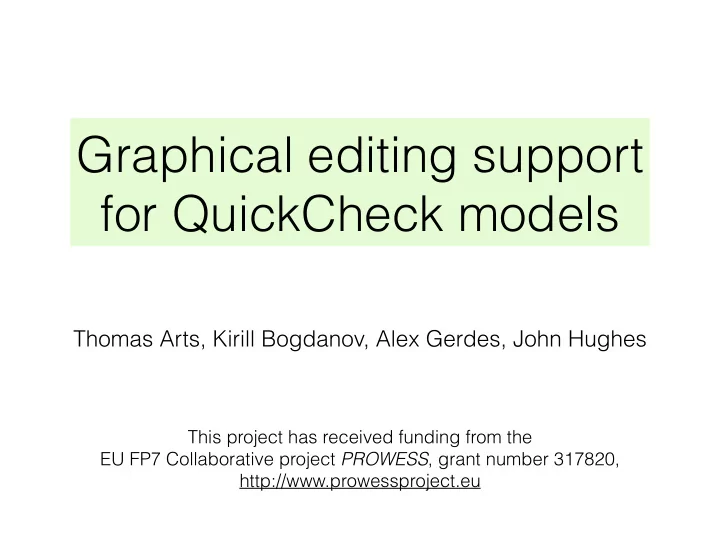

Graphical editing support for QuickCheck models Thomas Arts, Kirill Bogdanov, Alex Gerdes, John Hughes This project has received funding from the EU FP7 Collaborative project PROWESS , grant number 317820, http://www.prowessproject.eu
Testing with QuickCheck • QuickCheck permits one to write generators for test data and pre/postconditions. • The expectation is that user provides a model, based on which test data is randomly generated. • Illustration of testing a write operation: write_args(_) -> [key(), int()]. write(Key, Value) -> lock:write(Key, Value). write_post(_,[Key,Value],Res) -> eq(Res,ok).
Global state this is a type of the element of the operation precondition global state global state name write_pre(S) -> S#state.started precondition generator for write_args(S) -> [ key(), int() ]. arguments returns a generator list of arguments to pass to operation for integers write of the system under test returns a generator for keys Global state is a record-type of type state with element started , passed as an argument to all operations.
Testing write using global state Assuming started is a boolean component of the global state reflecting if the system was started, write_args(S) -> [key(), int()]. write(Key, Value) -> lock:write(Key, Value). write_pre(S) -> S#state.started write_post(S,[Key,Value],Res) -> eq(Res,ok). write_next(S, Res, [Key, Value]) -> S#state{kvs = [{Key,Value} | proplists:delete(Key,S#state.kvs)]}.
Locker example • Can be started/stopped • Can be locked/unlocked • Does not include read/write
Part of this diagram in pure QuickCheck lock_pre(S) -> S#state.started andalso not S#state.locked. lock_args(S) -> []. lock_next(S,Res,[])-> S#state{locked=true}. � unlock_pre(S) -> S#state.started andalso S#state.locked. unlock_args(S) -> []. unlock_next(S,Res,[])-> S#state{locked=false}. Very easy to make a mistake in one of the above expressions
Now if we are doing something more complex A lot of effort will go into ‘state maintenance’
Addition of a read transition around unlocked .
What we did • Developed a tool to edit graphical models. • Names of operations are extracted from Erlang code. • For the above example, the resulting model is half the size of the traditional model … … and much easier to maintain. • Test failures and frequencies are automatically extracted from results of test execution.
Frequencies Running tests produces a distribution of transitions
Weights can be updated Changing weights makes operations of interest run more frequently.
Conclusions • Existing QuickCheck models are hard to develop for complex state-transition diagrams. • Developed interface to edit such diagrams. • This will be part of the upcoming version of QuickCheck. • Currently working on the case study with an industrial partner - testing of the interface to video on demand system.
Recommend
More recommend